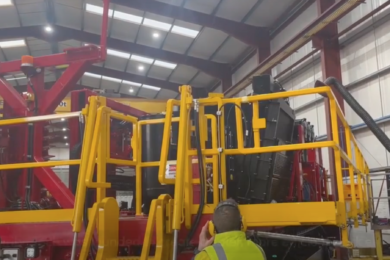Tribe Technology PLC has given an update in relation to the company’s first generation autonomous TTDS 700 GC reverse circulation drill rig. It says it continues to move forward in relation to the construction of its drill rig and recently successfully switched on the engine of the drill rig for the first time at the company’s 20,000 square foot facility near Belfast, Northern Ireland.
This marks an important step for Tribe Tech on the way towards factory completion of the drill rig and the subsequent production of the drill rig, “as well as ultimately, the advancement of efficiency, safety and sustainability in the drilling industry.”
Derek Loughlin, Chief Technology Officer at Tribe Tech, commented: “We continue to make strong progress in relation to the company’s first generation autonomous TTDS 700 GC drill rig and ultimately, towards creating a safer, more efficient work environment through the use of fully autonomous and safe drill rigs. This is demonstrated by the continued testing and most recently, the successful engine ignition of our first autonomously operated drill rig.”
Factory completion of the drill rig continues to be expected to occur in the first quarter of 2024 with shipment to the customer expected in second quarter of 2024, as originally stated in the company’s announcement on 28 December 2023. To date, reverse circulation drilling has been characterised by a lack of automation due to the complexities of the systems required and the harsh conditions in which these machines operate. The company’s RC drill rigs are being developed to remove operators from the dangers that are involved in traditional RC drill rigs.
Tribe Tech CEO Charlie King told IM during a visit to the factory back in 2022: “There is a huge degree of complexity in RC automation relating to the handling of rods and bits plus the cyclone sampling. You would typically have one or two people on the sampling; one person operating the rod handler; one person doing the actual drilling plus a supervisor plus maybe additional staff such as a geologist, health and safety professional or field assistant. We are very familiar with the challenges, however, due to projects our team members have worked on in previous roles; plus the sheer weight of engineering hours we have put into the TTDS development and the lessons we have learned along the way. I will say that a standard RC rig has three to five people operating it; whereas ours will have nobody on the drill pad at all and we have designed everything around that which has meant a colossal engineering project from the ground up.”
Australia represents a major market for large RC rigs, especially in the Pilbara iron ore hub, so this is the primary initial focus area for Tribe Tech with both mining houses and major drilling contractors. While the drill rig itself is being made in Northern Ireland, the sampling system has been built at the company’s facility in Perth, WA. In February, Tribe Tech’s Australian employees also had the chance to see some of Tribe Tech’s equipment being tested at the Australian Automation and Robotics Precinct (AARP)’s Dirt Lab in Neerabup, about 35 km north of Perth. With a hands-on demonstration, this was an opportunity for the team to get an in-depth look at the innovative automated RC technology.










